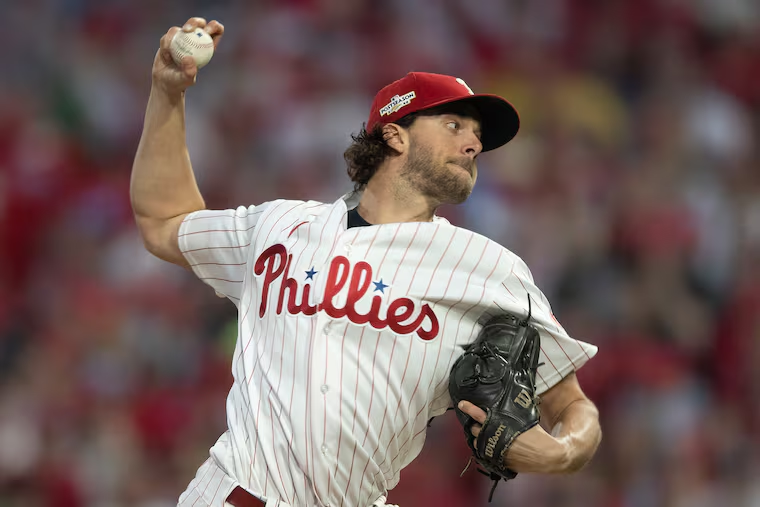Phillies take a big but manageable risk on Aaron Nola and position themselves to improve elsewhere
Nola’s future production matters a lot less to the Phillies than his performance in the here-and-now.

A fair deal.
That’s what the Phillies got themselves. That’s what they gave to Aaron Nola.
A smart deal?
That requires a little more thought. About biology. About physiology. About roster philosophy. About a slew of other factors — some known, some unknown, some impossible to know. To make matters even more complex, all of these variables are dependent on the time horizon you set for yourself.
Here is what we know as of Sunday: The Phillies have committed to paying Nola an average salary of $24.6 million through his 37-year-old season. That’s seven years and $172 million in total, according to what sources are telling The Inquirer. It’s the fourth-richest contract among active starting pitchers, placing Nola behind Yankees righty Gerrit Cole (nine years, $324 million), Nationals righty Stephen Strasburg (Seven years, $245 million), and Rangers righty Jacob deGrom (five years, $185 million). It ranks just ahead of the six-year, $162 million contract that Carlos Rodón signed with the Yankees last year.
» READ MORE: Source: Phillies, Aaron Nola agree to seven-year, $172 million contract
Those names and numbers point to the risk that the Phillies are taking. Strasburg, deGrom, and Rodón combined to throw 94⅔ innings last season. The latter two accounted for all of those innings, both in the first year of the monster deals they signed as the top two pitchers on last year’s free-agent market.
Yet neither deGrom nor Rodón entered free agency with the track record of durability that Nola has shown during his nine years with the Phillies. The 30-year-old right-hander just completed his fifth straight season of 32-plus starts, not including the pandemic-shortened season of 2020. After throwing a career-high 230⅔ innings in 2022 in the regular season and postseason combined, Nola followed it up with 216⅔ innings this year.
The workload has been remarkable. Since 2018, Nola’s 1,065⅓ regular-season innings rank second behind only Cole’s 1,076⅔. Only two other pitchers in the majors have reached the 1,000-inning threshold: the Blue Jays’ José Berríos (1,009⅓), and the Phillies’ Zack Wheeler (1007).
Of course, past results are no guarantee of future ones. The big question is whether the inverse is true. The aging curve for starting pitchers is what it is. Since 2008, only 19 pitchers have logged 900-plus innings from the ages of 31 to 36. That’s an average of 150 innings per season. Only eight of those pitchers have done it after 2018. Justin Verlander and Max Scherzer are the current standard bearers, although both boast bigger frames and live at higher velocities than Nola.
That brings us back to the question of time horizons.
» READ MORE: GMs were all in on the Phillies signing Nola
The Phillies would love for their current window of competitiveness to last the life of Nola’s new deal. In reality, it may not ever be opened wider than it is right now. Wheeler is only under contract for one more season. Kyle Schwarber and José Alvarado have two more years under contract. Within four years, Bryson Stott and Alec Bohm could both be in line for their own massive contracts.
In short, Nola’s future production matters a lot less to the Phillies than his performance in the here and now. The bottom line is that they needed every one of the innings that he logged this year, particularly in the postseason. Had he left, the Phillies would have struggled to replace those innings for anything close to $25 million per year. By keeping him in the fold, they achieve some near-term certainty with their rotation. They also give themselves an opportunity to focus on ways to build upon last year’s roster.
The Phillies entered the offseason with a projected payroll of roughly $188 million for 20 players. With Nola, that number jumps to about $212 million for 21 players. That would leave them with another $25 million before reaching the $237 million mark they carried into Opening Day last year.
» READ MORE: Phillies 2023 offseason tracker: Trade talk, signings, analysis, key dates, and more
Even if that’s an optimistic view of their spending potential, the main point is that they have the flexibility to add at least another couple of signings, with a right-handed bat and another high-leverage reliever topping their list of needs. They also have some room to maneuver if a bigger-ticket free agent or trade target becomes a possibility.
As for Nola’s ability to live up to the terms of his deal, the Phillies knew that they were going to be taking on a great deal of uncertainty with anybody they signed. They decided that the smarter money was on keeping a guy they know in a setting in which they have seen him succeed. It’s hard to argue with that line of thinking.